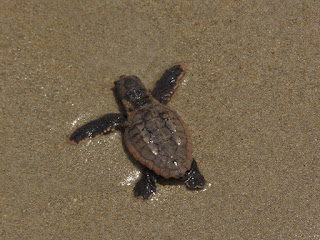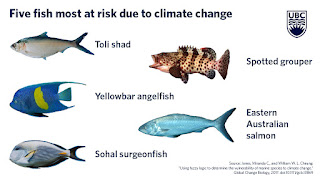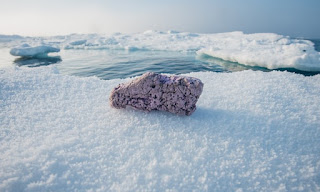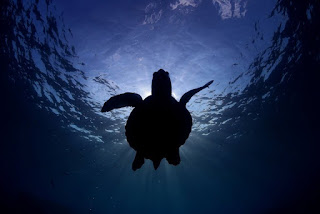1. Mass Extinction Could Happen Within Decades
 Previous mass extinction events – the last of which occurred 252 million years ago – are evidenced by carbon in marine sediments. Today marine carbon is accumulating faster than in the past. When carbon amounts in the environment meet a certain threshold, a mass extinction occurs. At the current rate, says scientist Daniel Rothman, this extinction could happen within decades, and certainly before the end of the century. By pumping enormous amounts of carbon into the environment, humanity is quite possibly setting the stage for a global sixth mass extinction event in the marine – and possibly terrestrial – environment.
Previous mass extinction events – the last of which occurred 252 million years ago – are evidenced by carbon in marine sediments. Today marine carbon is accumulating faster than in the past. When carbon amounts in the environment meet a certain threshold, a mass extinction occurs. At the current rate, says scientist Daniel Rothman, this extinction could happen within decades, and certainly before the end of the century. By pumping enormous amounts of carbon into the environment, humanity is quite possibly setting the stage for a global sixth mass extinction event in the marine – and possibly terrestrial – environment.
-----------------------------------------------
2. Certain Fish Species Most Vulnerable to Climate Change
 A new study looked at the data for 1,074 marine species and concluded that 294 species are at risk (by 2050) due to climate change. The worst off are the “Eastern Australian salmon, yellowbar angelfish, toli shad, sohal surgeonfish and spotted grouper. The researchers created a database to highlight the fish most vulnerable, in the long-term, of those important to fisheries worldwide.
Read More...
A new study looked at the data for 1,074 marine species and concluded that 294 species are at risk (by 2050) due to climate change. The worst off are the “Eastern Australian salmon, yellowbar angelfish, toli shad, sohal surgeonfish and spotted grouper. The researchers created a database to highlight the fish most vulnerable, in the long-term, of those important to fisheries worldwide.
Read More...
3. Plastic Chunks Found on Remote Arctic Ice2. Certain Fish Species Most Vulnerable to Climate Change
 A new study looked at the data for 1,074 marine species and concluded that 294 species are at risk (by 2050) due to climate change. The worst off are the “Eastern Australian salmon, yellowbar angelfish, toli shad, sohal surgeonfish and spotted grouper. The researchers created a database to highlight the fish most vulnerable, in the long-term, of those important to fisheries worldwide.
A new study looked at the data for 1,074 marine species and concluded that 294 species are at risk (by 2050) due to climate change. The worst off are the “Eastern Australian salmon, yellowbar angelfish, toli shad, sohal surgeonfish and spotted grouper. The researchers created a database to highlight the fish most vulnerable, in the long-term, of those important to fisheries worldwide.
-----------------------------------------------
 Plastic in the oceans is widespread, but now scientists how found a new source: melting ice. Polystyrene pieces were found in the remote Arctic (1,000 miles from the North Pole). This shows how widespread plastic pollution in the oceans is. Scientists estimate there are 5 trillion pieces of plastic on the surface of the oceans. Some 300 million tons of plastics are produced a year, and half is single-use plastics.
Plastic in the oceans is widespread, but now scientists how found a new source: melting ice. Polystyrene pieces were found in the remote Arctic (1,000 miles from the North Pole). This shows how widespread plastic pollution in the oceans is. Scientists estimate there are 5 trillion pieces of plastic on the surface of the oceans. Some 300 million tons of plastics are produced a year, and half is single-use plastics.-----------------------------------------------

A recent study has shown that nanoplastics accumulate in fishes’ brains, meaning that the nanoplastics can cross the blood-brain barrier. Fish affected by nanoplastic show behavioral disorders such as eating more slowly and exploring around them less. Animal plankton die when exposed to nanoplastics but are unaffected by larger pieces of plastic. "It is important to study how plastics affect ecosystems and that nanoplastic particles likely have a more dangerous impact on aquatic ecosystems than larger pieces of plastics," says researcher Tommy Cedervall.
Read More...
-----------------------------------------------
5. Dolphins As Sentinels of Ocean Health
 A long-term study off the southeastern United States found that two populations of dolphins had “extraordinarily high” instances of disease. Only 43 percent of the dolphins in the study were deemed healthy. The rest had diseases associated with bacteria, viruses and fungi. Antibiotic resistance was also high. Pesticides and industrial chemicals are thought to be the cause of the diseases. The researchers warn that humans who ingest seafood could also be vulnerable to pollution impacts.
A long-term study off the southeastern United States found that two populations of dolphins had “extraordinarily high” instances of disease. Only 43 percent of the dolphins in the study were deemed healthy. The rest had diseases associated with bacteria, viruses and fungi. Antibiotic resistance was also high. Pesticides and industrial chemicals are thought to be the cause of the diseases. The researchers warn that humans who ingest seafood could also be vulnerable to pollution impacts.
-----------------------------------------------
6. Sea Turtle Populations Bouncing Back Worldwide
Most sea turtle populations around the world are on the rise. This is good news, because six of seven species are still listed by the IUCN as vulnerable, endangered or critically endangered. Some populations are declining, like leatherback sea turtles in the Eastern and Western Pacific. Conservation efforts to protect beaches and regulate fishing, and the establishment of marine protected areas, have significantly helped sea turtle populations rebound.
Read More...
Read More...
-----------------------------------------------
Be sure to "LIKE" http://facebook.com/SeaSave to ensure our "Week in Review" is delivered to your newsfeed every Friday.
Be sure to "LIKE" http://facebook.com/SeaSave to ensure our "Week in Review" is delivered to your newsfeed every Friday.
Sea Save Foundation is committed to raising awareness of marine conservation. The Week in Review is a team effort produced by the Sea Save staff to provide a weekly summary of the latest in marine research, policy, and news.
